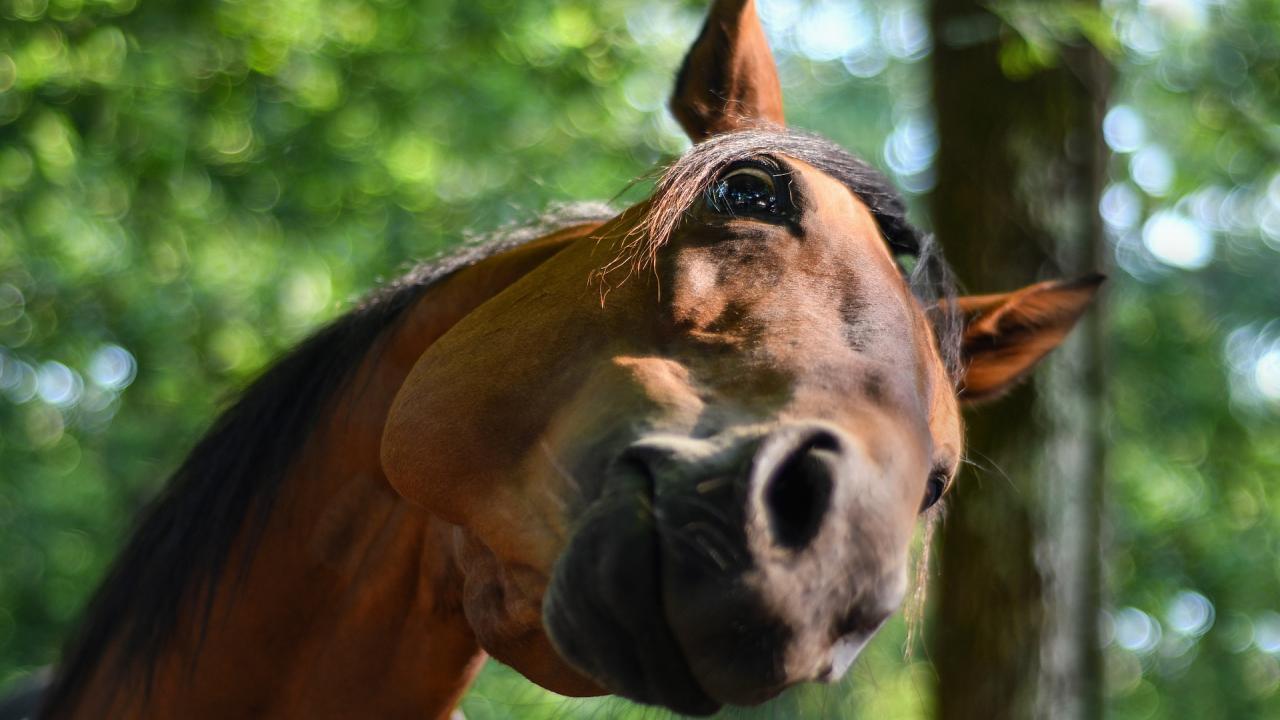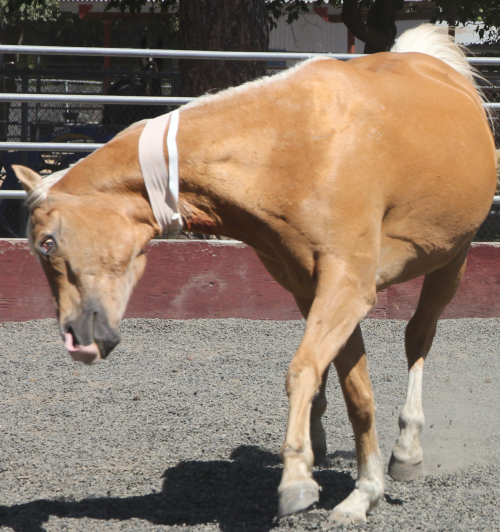
Trigeminal-mediated Headshaking
What is trigeminal-mediated headshaking?
Takeaways
- Trigeminal-mediated headshaking is characterized by uncontrollable shaking, flicking, or jerking of the head without any apparent cause.
- Headshaking can be triggered in response to wind, light, or increased exercise intensity in affected horses.
- There is currently no specific or curative treatment for trigeminal-mediated headshaking.
- There are currently no known measures for the prevention of trigeminal-mediated headshaking.
Trigeminal-mediated headshaking, formerly known as idiopathic headshaking, is a condition characterized by uncontrollable shaking, flicking, or jerking of the head, sometimes violently, without any apparent cause. Although the first case was described over 100 years ago, headshaking is still not well understood.
Research performed at UC Davis confirmed the involvement of the trigeminal nerve, a large nerve that runs across the face. In affected horses, this nerve has a very low threshold for activation, meaning that it fires spontaneously or with minimum stimulus. This causes the horse to experience tingling, itching, or burning sensations. The exact mechanism is unclear since the nerve appears normal under microscopic examination.
Trigeminal-mediated headshaking occurs around the world, affecting approximately 1% of horses. All breeds are susceptible. The condition can occur at any age (average age of onset is 9 years). Geldings appear to be the most commonly affected group.
Headshaking is seasonal in approximately 60% of affected horses, with peaks occurring in the summer in the United States. Clinical signs can be triggered in response to wind, light, high pitched sound, or increased exercise intensity. This can result in impaired performance in affected horses. In severe cases, horses may experience self-inflicted trauma and the condition can interfere with eating, leading to compromised welfare. These cases can become dangerous for both horses and riders/handlers.

What are the clinical signs of trigeminal-mediated headshaking?
Horses affected with trigeminal-mediated headshaking, commonly referred to as “headshakers”, exhibit clinical signs that may include an anxious expression, snorting, rubbing their
noses, and shaking, flicking, or jerking their heads, usually vertically, consistently or intermittently without any apparent cause. They may strike at their face with their forelimbs.
Clinical signs of trigeminal-mediated headshaking can come on suddenly or gradually, with some horses more severely affected than others. They can be triggered by changes in weather, loud sounds, vibrations, and exercise. Those with severe clinical signs on bright, sunny days are termed “photic headshakers”.
How is trigeminal-mediated headshaking diagnosed?
There is no single test for trigeminal-mediated headshaking. It is primarily diagnosed based on clinical signs, physical examination and detailed overview of the horse’s history, including evaluation of weather patterns linked to onset of clinical signs and how the horse is managed. Ear, eye, and dental exams, as well as CT and MRI scans, may be performed to investigate other causes. X-ray, endoscopy, and nerve blocks may also be employed.
It is important to rule out other reasons for the clinical signs such as sinusitis, dental issues (tooth abscess, dental disease, fractured tooth), viral infection, ear infection, ear mites (Trombicula autumnalis), ear ticks (Otobius megnini), foreign bodies, tumors, neck pain, temporohyoid osteoarthropathy, guttural pouch disorders, ethmoid hematomas, cysts or masses in the eyes, ill-fitting tack, and behavior disorders.
How is trigeminal-mediated headshaking treated?
There is no specific or curative treatment for trigeminal-mediated headshaking. Avoiding known triggers can alleviate clinical signs, but this approach may be impractical. Nose nets and fly masks with ultraviolet light protection have been reported to provide some improvement in clinical signs, but full resolution is rare. Medications have variable success and side effects are possible. Note that these drugs are used to help control the nerve pain associated with headshaking and do not address or correct the root cause. Chiropractic and acupuncture treatment do not appear to reliably alleviate headshaking.
Recently, UC Davis researchers have shown that adding magnesium and boron to the diet of a small number of affected horses led to a significant reduction in headshaking, with the most severely affected horses exhibiting the greatest benefit. It is important to have a veterinarian monitor the magnesium level in your horse’s blood if magnesium supplementation is provided to make sure it is not too high. Additional research is needed in this area to determine if supplementation can be recommended to treat affected horses. It is also important to concurrently increase the pH of the diet by offering alfalfa (no more than 50% of the total diet) or avoiding grain (lowers pH). The beneficial effects of magnesium are better when the diet is more alkaline (higher pH).
What is the prognosis for trigeminal-mediated headshaking?
Since the clinical signs and response to treatment are extremely variable, the prognosis for trigeminal mediated headshaking is case-dependent. Some horses can be managed to limit or reduce clinical signs, providing some relief. There is no cure for trigeminal-mediated headshaking and extreme cases may require euthanasia.
How can trigeminal-mediated headshaking be prevented?
There are currently no known measures for the prevention of trigeminal-mediated headshaking.
For more information
Trigeminal Nerve Pain/Headshaking, Equine and Comparative Neurology Research Group
Aleman, M., Williams, D.C., Brosnan, R.J., Nieto, J.E., Pickles, K.J., Berger, J., LeCouteur, R.A., Holliday, T.A., Madigan, J.E. 2013. Sensory Nerve Conduction and Somatosensory Evoked Potentials of the Trigeminal Nerve in Horses with Idiopathic Headshaking. J Vet Intern Med 27:1571-1580.
Pickles, K., Madigan, J., Aleman, M. 2014. Idiopathic headshaking: Is it still idiopathic. Vet J 201(1):21-30.
*This article may not be reproduced without the written consent of the UC Davis Center for Equine Health. Please email requests to cehadmin@ucdavis.edu.
